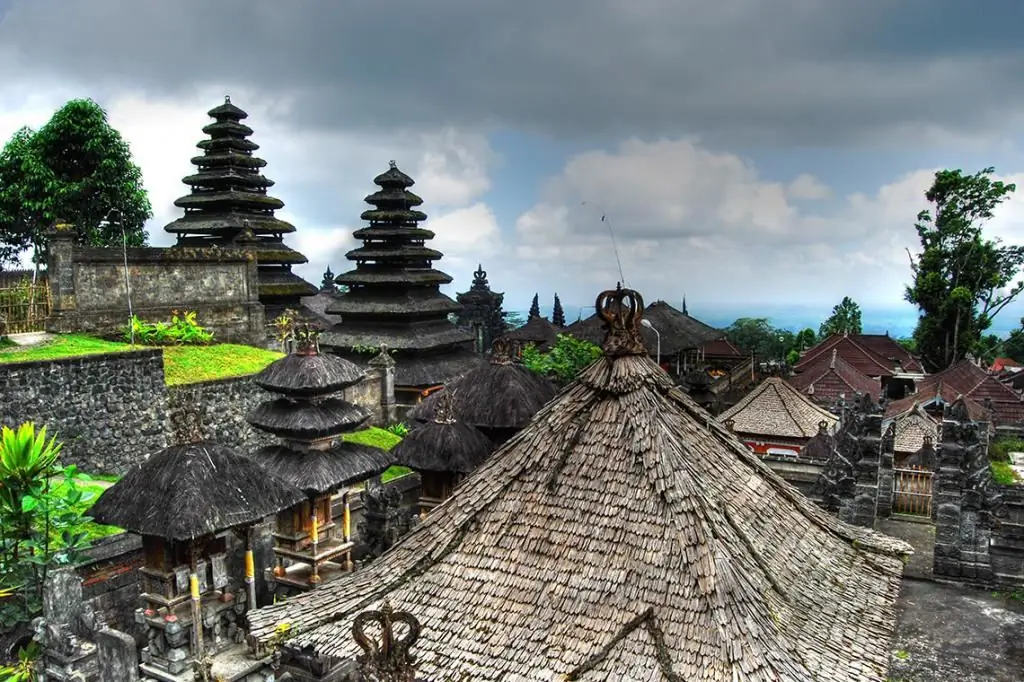- Author Harold Hamphrey [email protected].
- Public 2023-12-17 10:06.
- Last modified 2025-01-24 11:10.
People go to Bali mainly for the sea, sun and spa treatments. But as a rule, tourists are captured by the spirituality of this "island of a thousand temples." It is worth spending at least a few days in Bali, as you will feel that the other world is the same reality as our world.
Indonesia is a Muslim country. But if on other islands tourists see only mosques with minarets, then in Bali - a stronghold of Hinduism in an Islamic state - they are met by a variety of temples.
There are a million gods in the pantheon of this religion. This means that there should be no less temples dedicated to them. These shrines range from majestic huge religious complexes to small altars in the backyard.
In this article, we will list the temples in Bali that tourists should see. In addition to describing the sanctuaries, we will give practical recommendations and advice regarding visiting times, ticket prices, and more.

A little about Agama Hindu Dharma
Religiosity of the inhabitantsBali can seem naive and even funny to a tourist, especially when he sees how the locals cook food for the spirits and treat their dead ancestors with various delicacies. But if you understand the basics of Agama Hindu Dharma, in other words, Balinese Hinduism, then you can understand that deep spirituality is hidden behind external idolatry.
Inhabitants of the island believe that there are three principles in the world: creation, balance and destruction. Buddhism had a huge impact on the Hinduism of the locals.
However, ancient animism - the belief that objects have a soul - did not disappear, but merged with new religions into an amazing mixture. Everyone knows that Bali is an island of a thousand temples. But few understand that the locals really communicate with the gods and souls of their ancestors there.
They believe that this world is permeated with energy that has otherworldly origins. She can both help people in their endeavors and destroy their plans.

What are the types of religious buildings
No one knows how many temples there are in Bali, not even the locals themselves. But in every village, even the smallest one, there must certainly be at least three religious buildings.
In the upper part of the village, considered the cleanest, is Pura Puseh. This temple is dedicated to the guardian Vishnu and is reserved for very important ceremonies.
Pura Desa stands in the center of the village. In this temple dedicated to the creator Brahma, the usual ceremonies are held, the elders gather here for councils.
Finally, at the bottom of the village rises PuraDalem. The name literally translates as "Temple of the Dead". It is dedicated to the destroyer Shiva. Funeral ceremonies are held in this temple.
But destruction is not an end in Bali. After all, destruction is inextricably linked with creation, it precedes creation.
Besides these temples, in each courtyard there are small altars in the form of houses on high stands. In them you can see miniature figurines in black and white or checkered sarongs.
These are images of ancestral spirits. Three times a day - in the morning, at noon and at sunset - the inhabitants present them with baskets of flowers and food, and burn incense in front of them.

Sanctuary plan
According to this religious hierarchy, the great temples of Bali also consist of three courtyards. A tourist should not be limited to visiting the first of them. This courtyard is dedicated to Shiva.
You should go through all the zones, since each of them carries its own semantic load. The decor of the buildings and their interiors are also deeply symbolic. Temples have high pyramidal roofs. They are covered with palm fiber. This material in Bali is forbidden to be used for secular buildings.
Usually large temple complexes are located near water or on high coastal cliffs. This means that the shrines protect the island from evil demons.
Tourist visits to temples
The Balinese do not believe that an atheist or a non-believer defiles a holy place with his visit. However, there are certain clothing requirements. Ideally, this should be a national sarong costume.
But not to make a longexcursion in not very comfortable clothes! Sarongs can be rented at the entrance to all the important temples in Bali.
Some shrines offer this service for free, others don't, so it's best to wear off-the-shoulder clothing and bring a large headscarf. Tie it around your waist like a skirt, and you won't have any problems with the dress code.
Men wearing long trousers do not need a headscarf, but the rules require a special “bulang” to be girded. If you do not want to buy or rent it, take the same scarf, fold it with a bundle and wrap it around your waist.
Before entering the temple building, you must take off your shoes. Inside, make sure that your head is not higher than the priest conducting the ceremony. It's better to sit on the polished floor.
Again, watch your feet. These dirty (from the point of view of the Balinese) body parts should not point to temple sculptures, a priest, or anyone else at all - here it is considered an insult. If you want to take photos of temples in Bali, turn off the flash.
When moving around the building, especially during the ceremony, do not go beyond the line of prayer. Blood has no place in the temple. Therefore, people with open wounds may not be allowed there. By the way, Balinese women do not visit the sanctuary during critical days, as well as in some period after childbirth.
Besakih Bali Temple
This most important religious complex is located at an altitude of a thousand meters above sea level, on the slopes of the Agung volcano. The Balinese consider the fire-breathing mountain to be the abode of the destroyer god Shiva.
In 1963, when Agung suddenly “woke up”and buried under volcanic ash about two thousand people, lava flows passed a few meters from Pura Besakih. The name translates as "Mother of all temples". And it really is the most important sanctuary on the island.
The religious complex consists of 23 temples, the main of which is Penataran Agung (altar of Shiva). To visit the Besakih Temple (Bali) on your own, and not as part of an excursion, you should get out of the town of Kintamani.
You can also take a taxi - the distance from the resort of Kuta to Besakih is 62 kilometers. Due to the terrain, the road will take an hour and a half one way.
This complex is over a thousand years old. It descends in terraces down the mountainside, and its buildings are made of volcanic lava. The entrance ticket costs 35 thousand Indonesian rupiah, or 153 rubles.
Travel Tip: If you want to see Bali at your feet, visit the Besakih temple complex in the early afternoon. Clouds roll in after lunch and visibility deteriorates.

Pura Luhur Uluwatu
If Besakih is Bali's most important temple, then Luhur Uluwatu is the most impressive in location. It rises on a coastal cliff, which breaks into the ocean with a 70-meter abyss.
This temple is very revered in Bali, because the locals believe that the energy essences of Brahma, Vishnu and Shiva unite here. Everything in this complex is dedicated to trimurti - the unity of the beginning and end of the Universe.
It is believed that since the rock on which the temple rises withstands the onslaught of ocean waves and does notcrumbles, so the monastery protects Bali from evil spirits. To make the protection even more reliable, monkeys are fed near the temple in a grove. Tourists warn: the seemingly cute creatures are very prone to theft. They especially like mobile phones and sunglasses.
If legends are to be believed, Uluwatu Temple in Bali was founded a thousand years ago. Indeed, the temple gates, decorated with elaborate carvings, date back to the 10th century. This temple is popular with tourists not only because it offers insanely beautiful views and you can admire the sunset. The religious dance kechak is performed daily on the observation deck. Tourists recommend going here in the evening. First, for the dance, and second, for the sunset. There is almost no shade here, so during the day the heat on the rock is unbelievable.
Entrance to the temple costs 30 thousand rupees (131 rubles), for kechak from the audience they charge an additional fee. Uluwatu is located on the Bukit Peninsula, south of Bali. It takes about an hour to get here from Kuta. But regular buses do not go here.

Pura Tanah Lot
The name of this 16th century sanctuary translates as "Land in the Sea". And for sure: Tanah Lot rises on a small cliff, which can only be approached at low tide.
Tourists recommend visiting the Bali temple on the water as part of an excursion, because otherwise you will have to stray among the remote villages along the highway without road signs. It is best to shoot the temple from afar at high tide. Then the coastal cliff turns into an island.
Tourists warn: for entering the territory of a religiouscomplex require 30 thousand rupees (131 rubles) per person, but non-Hindu are allowed only in the lower courtyard. But still, Pura Tanah Lot is definitely worth a visit. This is the most advertised temple on the island.
Nearby is another religious complex - Pura Batu Bolong, also included in the Top 5 most beautiful temples in Bali. It also rises on the coastal cliff. But the latter is connected to the island of Bali by a high passage, under which the sea has hollowed out an arch. These two shrines are closest to Legian Beach (17 kilometers).

Pura Oolong Danu
The best temples in Bali are located not only by the sea, but also inland. It is very difficult to get along the mountain serpentine to the village of Bedugul untouched by civilization (1300 meters above sea level), but the impressions from what you see fully pay off the hardships of the journey.
Pura Ulun Danu is located on the shores and islets of the crater volcanic lake Bratan. This temple with a multi-tiered pagoda was built in 1633. It is dedicated to the goddess of fresh water, Virgin Dan. But both Shiva and Parvati are honored in this Hindu-Buddhist temple.
Also on the territory of the sanctuary you can see the statues of the Enlightened One. This temple is so popular in Bali that its image can be seen on the local banknote of 50 thousand rupees (equivalent to 218 rubles).
Tourists are advised to arrive early in the morning. At this hour, the temple is enveloped in a light fog, and there are few people. The entrance to the sanctuary is paid.
The distance from the popular resort of Kuta to Ulun Danu is more than 60 kilometers, the road will take about twohalf hours. Denpasar is the best way out.

Lempuyang Temple (Bali)
This sanctuary is located in the east of the island, not far from the resort of Ameda with paradise beaches. You can get to the temple only by rented car/scooter or as part of a tour.
Guides, when recruiting a group, often keep silent about the fact that "Lempuyang" is translated as "Road to Heaven". In order to get to the temple, tourists will have to climb the path through the jungle to the 800-meter mountain.
To make such tracking almost without problems, it is better to get out at dawn, before the heat comes. Along the way, you will need to climb 1700 steps, the journey will take four hours.
Lempuyang Temple (Bali) is a huge complex. As befits the "Stairway to Heaven", each building in it is higher than the previous one. Insanely beautiful, dizzying views of the ocean and Agung volcano open from the lower courtyard of the temple.
But believers do not stop there, but go to meditate on the topmost shaded terrace. Lempuyang is rarely visited by tourists due to its inaccessibility. Thanks to this circumstance, the authentic atmosphere of the holy place is preserved.

Pura Goa Lavah
Of all the temples in Bali, this one is the most unusual. Goa Lawah is located in the southeast of the island. The nearest resort is Ubud. From Kuta you can take a bus to the village of Padang Bay, but then you have to walk 5 kilometers.
The name of the sanctuary is translated as "temple of bats". It is located on the shore near a huge cave, which (according to unverified rumors) extends inland for 30 kilometers up to Pura Besakih.
The main tourist attraction of the 11th century temple is its inhabitants - hundreds of thousands of fruit bats. And the whole stone decor of Goa Lavah is also dedicated to these little creatures.
Like Europeans, in Bali bats are associated with the underworld. Therefore, the temple is mainly dedicated to funeral ceremonies. Cremations take place on the beach. But these terrible ceremonies and hordes of bats hanging from the roof of the cave only add to the popularity of the temple with tourists.
The gates of the complex symbolize good and evil, split in the form of a pagoda, the vertical halves of which are moved apart in different directions. Two sacred banyan trees grow nearby.
In the first courtyard there are altars to the divine triad - Vishnu, Shiva and Brahma. After passing the next gate, the visitor will see a statue of a dragon protecting the monastery from evil spirits. Religious ceremonies are held here, accompanied by dances and music.
And finally, the third courtyard is actually a huge grotto - the entrance to the cave. Thousands of bats hang from the ceiling, the pungent smell of their droppings is in the air, the constant rustle of wings and squeak is heard.

Taman Ayun
Christianity knows such a thing as a palace church. There is something similar in Bali. The "Island of Temples" has another sanctuary - built in 1634 for the ruler Mengwi.
Name "TamanAyun" translates as "charming garden". And this is not just a beautiful metaphor. The temple complex, of course, is dedicated to the gods, but it was conceived as a resting place for the royal family.
The buildings of the pagodas and shrines are made in the elaborate Chinese architectural style. Among the statues of deities and mossy stones, ponds with lotuses and goldfish can be seen. Bridges, bright tropical vegetation, fragrant flowers - the architect Hobin Ho was invited to reconstruct the landscape park in 1750.
To prevent the equatorial sun from drying up the greenery, he came up with a special irrigation system - subak. It is because of her that the Taman Ayun temple complex is included in the UNESCO list.
Tourists report that, unlike other places of worship in Bali, there are few tourists in this sanctuary, and therefore it is also difficult to meet annoying traders and pseudo-guides. Near the entrance (the fee for it is purely symbolic) is a small market where you can eat tasty and cheap.

The temple complex traditionally consists of three zones, located one above the other. Tourists are not allowed into the highest one - it is open only to believers, and even then on the most significant religious holidays. But travelers say that the remaining three yards are more than enough for strong impressions.
This beautiful temple is surprisingly organically inscribed in the surrounding landscape. To get to Taman Ayun, you need to go north from the Denpasar resort. After 17 kilometers you will reach the village of Mengvi. Excursions rarely come here, so the temple complex is available only forindependent tourists.






